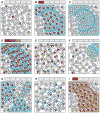Passenger mutations as a marker of clonal cell lineages in emerging neoplasia
- PMID: 20951806
- PMCID: PMC2993762
- DOI: 10.1016/j.semcancer.2010.10.008
Passenger mutations as a marker of clonal cell lineages in emerging neoplasia
Abstract
Cancer arises as the result of a natural selection process among cells of the body, favoring lineages bearing somatic mutations that bestow them with a proliferative advantage. Of the thousands of mutations within a tumor, only a small fraction functionally drive its growth; the vast majority are mere passengers of minimal biological consequence. Yet the presence of any mutation, independent of its role in facilitating proliferation, tags a cell's clonal descendants in a manner that allows them to be distinguished from unrelated cells. Such markers of cell lineage can be used to identify the abnormal proliferative signature of neoplastic clonal evolution, even at a stage which predates morphologically recognizable dysplasia. This article focuses on molecular techniques for assessing cellular clonality in humans with an emphasis on how they may be used for early detection of tumorigenic processes. We discuss historical as well as contemporary approaches and consider ways in which powerful new genomic technologies might be harnessed to develop a future generation of early cancer diagnostics.
Copyright © 2010 Elsevier Ltd. All rights reserved.
Conflict of interest statement
The authors declare that there are no conflicts of interest.
Figures



Similar articles
-
Somatic variation in normal tissues: friend or foe of cancer early detection?Ann Oncol. 2022 Dec;33(12):1239-1249. doi: 10.1016/j.annonc.2022.09.156. Epub 2022 Sep 23. Ann Oncol. 2022. PMID: 36162751 Review.
-
Clonal origins and parallel evolution of regionally synchronous colorectal adenoma and carcinoma.Oncotarget. 2015 Sep 29;6(29):27725-35. doi: 10.18632/oncotarget.4834. Oncotarget. 2015. PMID: 26336987 Free PMC article.
-
Evolution of genetic instability in heterogeneous tumors.J Theor Biol. 2016 May 7;396:1-12. doi: 10.1016/j.jtbi.2015.11.028. Epub 2016 Jan 27. J Theor Biol. 2016. PMID: 26826489 Free PMC article.
-
Using Somatic Mutations from Tumors to Classify Variants in Mismatch Repair Genes.Am J Hum Genet. 2018 Jul 5;103(1):19-29. doi: 10.1016/j.ajhg.2018.05.001. Epub 2018 Jun 7. Am J Hum Genet. 2018. PMID: 29887214 Free PMC article.
-
[Molecular indicators of neoplasia in clinical diagnostics].Pol Merkur Lekarski. 2005 Mar;18(105):323-8. Pol Merkur Lekarski. 2005. PMID: 15997644 Review. Polish.
Cited by
-
Next-Generation Genotoxicology: Using Modern Sequencing Technologies to Assess Somatic Mutagenesis and Cancer Risk.Environ Mol Mutagen. 2020 Jan;61(1):135-151. doi: 10.1002/em.22342. Epub 2019 Nov 11. Environ Mol Mutagen. 2020. PMID: 31595553 Free PMC article. Review.
-
A Revised Stem Cell Theory for the Pathogenesis of Endometriosis.J Pers Med. 2022 Feb 4;12(2):216. doi: 10.3390/jpm12020216. J Pers Med. 2022. PMID: 35207704 Free PMC article. Review.
-
Next-generation sequencing methodologies to detect low-frequency mutations: "Catch me if you can".Mutat Res Rev Mutat Res. 2023 Jul-Dec;792:108471. doi: 10.1016/j.mrrev.2023.108471. Epub 2023 Sep 15. Mutat Res Rev Mutat Res. 2023. PMID: 37716438 Free PMC article. Review.
-
Teaching cancer imaging in the era of precision medicine: Looking at the big picture.Eur J Radiol Open. 2022 Mar 15;9:100414. doi: 10.1016/j.ejro.2022.100414. eCollection 2022. Eur J Radiol Open. 2022. PMID: 35309874 Free PMC article. Review.
-
Clonal expansions and short telomeres are associated with neoplasia in early-onset, but not late-onset, ulcerative colitis.Inflamm Bowel Dis. 2013 Nov;19(12):2593-602. doi: 10.1097/MIB.0b013e3182a87640. Inflamm Bowel Dis. 2013. PMID: 24097228 Free PMC article.
References
-
- Loeb LA, Springgate CF, Battula N. Errors in DNA replication as a basis of malignant changes. Cancer Res. 1974;34:2311–21. - PubMed
-
- Cairns J. Mutation selection and the natural history of cancer. Nature. 1975;255:197–200. - PubMed
-
- Nowell PC. The clonal evolution of tumor cell populations. Science. 1976;194:23–8. - PubMed
-
- Hanahan D, Weinberg RA. The hallmarks of cancer. Cell. 2000;100:57–70. - PubMed
Publication types
MeSH terms
Grants and funding
LinkOut - more resources
Full Text Sources
Other Literature Sources

